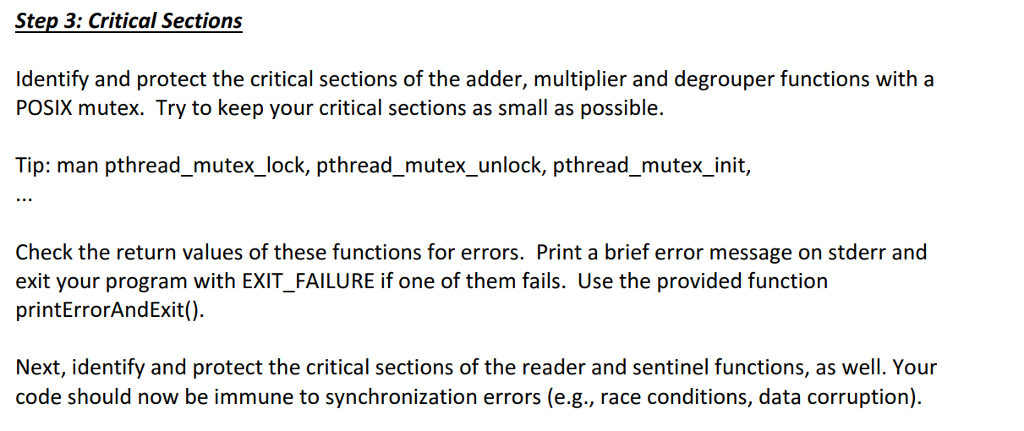Question
C Programming questions: Q6: Is a new mutex, separate from what you have in Step 3, required to correctly implement this behavior? Why or why
 C Programming questions:
C Programming questions:
Q6: Is a new mutex, separate from what you have in Step 3, required to correctly implement this behavior? Why or why not?
Q7: Why is it important, even on single-processor machines, to keep the critical sections as small as possible?
Q8: Why is spin-waiting without yielding usually inefficient?
Q9: When might spin-waiting without yielding or blocking actually be *more* efficient?
Q10: You have to supply an initial value when creating a semaphore. Which value should you use to mimic the default functionality of a mutex? What would happen if you specified a larger value?
Step 3: Critical Sections Identify and protect the critical sections of the adder, multiplier and degrouper functions with a POSIX mutex. Try to keep your critical sections as small as possible. Tip: man pthread_mutex_lock, pthread_mutex_unlock, pthread_mutex_init, Check the return values of these functions for errors. Print a brief error message on stderr and exit your program with EXIT_FAILURE if one of them fails. Use the provided function printErrorAndExit(). Next, identify and protect the critical sections of the reader and sentinel functions, as well. Your code should now be immune to synchronization errors (e.g., race conditions, data corruption) Step 3: Critical Sections Identify and protect the critical sections of the adder, multiplier and degrouper functions with a POSIX mutex. Try to keep your critical sections as small as possible. Tip: man pthread_mutex_lock, pthread_mutex_unlock, pthread_mutex_init, Check the return values of these functions for errors. Print a brief error message on stderr and exit your program with EXIT_FAILURE if one of them fails. Use the provided function printErrorAndExit(). Next, identify and protect the critical sections of the reader and sentinel functions, as well. Your code should now be immune to synchronization errors (e.g., race conditions, data corruption)Step by Step Solution
There are 3 Steps involved in it
Step: 1

Get Instant Access to Expert-Tailored Solutions
See step-by-step solutions with expert insights and AI powered tools for academic success
Step: 2

Step: 3

Ace Your Homework with AI
Get the answers you need in no time with our AI-driven, step-by-step assistance
Get Started


